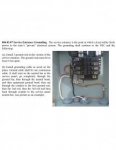BlaineXD
Member
- Location
- Rockville, MD
 I am reviewing some specs and came across this section. I was wondering what you all thought of creating a loop with the grounds and connecting the ends back together, like the state is suggesting. It is not a configuration that I am familiar with. I am new to the field, but I know that a grounding system can and-- in an industrial setting-- generally does have some amount of current on it. By creating this loop, would you be degrading and making a less efficient system? I mean, because the path of least resistance is a loop? Also, what implications would this have for cathodic protection and the degradation of components (lugs, cables, and such) over time?
I am reviewing some specs and came across this section. I was wondering what you all thought of creating a loop with the grounds and connecting the ends back together, like the state is suggesting. It is not a configuration that I am familiar with. I am new to the field, but I know that a grounding system can and-- in an industrial setting-- generally does have some amount of current on it. By creating this loop, would you be degrading and making a less efficient system? I mean, because the path of least resistance is a loop? Also, what implications would this have for cathodic protection and the degradation of components (lugs, cables, and such) over time?Thanks for any insights and opinions.
--Nate

